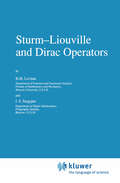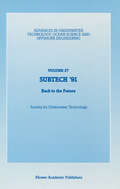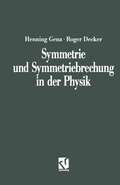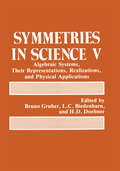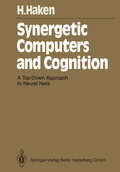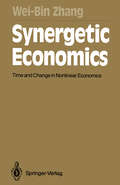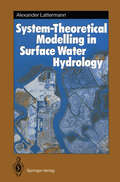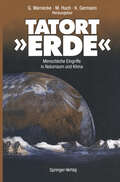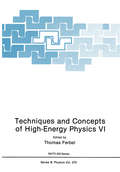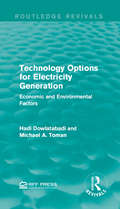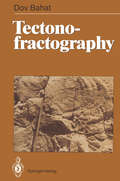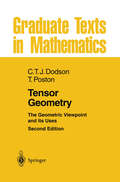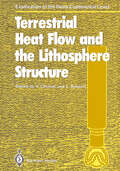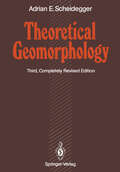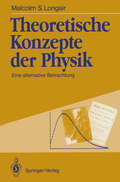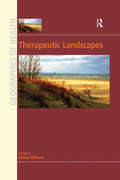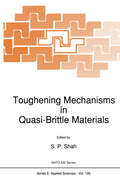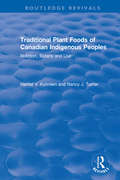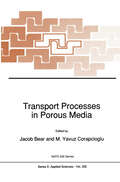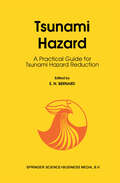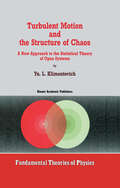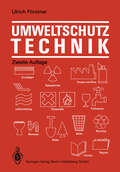- Table View
- List View
SUBTECH ’91: Back to the Future. Papers presented at a conference organized by the Society for Underwater Technology and held in Aberdeen, UK, November 12–14, 1991 (Advances in Underwater Technology, Ocean Science and Offshore Engineering #27)
by Society for Society for Underwater Technology (SUT)The concept of using flexible, reelable pipe to transport liquids, gases, and vapours is not a new one. As early as the 1940s a steel braided elastomeric pipeline was developed for the Allied Forces in order to transport fuels to support the Normandy Beacheads. In fact, the longest flexible pipeline ever constructed is likely to be that laid across the English Channel as part of 'Operation Pluto'. The methodology used to handle and instal such pipe is also not new. Ellis (1943, London) in an early patent specification identifies three basic objectives for a flexible pipelining method. These are: prefabrication of the pipe onshore; coiling of the pipe on suitable drums or reels; and using such reels to lay pipe from anchored or motorised barges. The design concept for flexible pipe is also not a new invention given that flexible hoses and umbilicals have been in service for more than sixty years. A break-through was however achieved by the French Institute of Petroleum in the early 1970s when they developed an improved steel reinforced pipe structure having a high axial loading capaci ty which utilised corrosion and hydrocarbon resistant polymers to extend pipe service lifetime. This early pipe design utilised established cable making techniques to apply steel armour and axially and radially reinforce alternating layers of polymer sheaths. The pipe was primarily developed as a flowline for use in static seabed applications.
Symmetries in Science V: Algebraic Systems, Their Representations, Realizations, and Physical Applications
by Bruno Gruber L. C. Biedenharn H. D. DöbnerProceedings of a symposium held in Landesbildungszentrum Schloss Hofen, Lochau, Vorarlberg, Austria, July 30-August 3, 1990
Synergetic Computers and Cognition: A Top-Down Approach to Neural Nets (Springer Series in Synergetics #50)
by Hermann HakenThis book presents a novel approach to neural nets and thus offers a genuine alternative to the hitherto known neuro-computers. The new edition includes a section on transformation properties of the equations of the synergetic computer and on the invariance properties of the order parameter equations. Further additions are a new section on stereopsis and recent developments in the use of pulse-coupled neural nets for pattern recognition.
Synergetic Economics: Time and Change in Nonlinear Economics (Springer Series in Synergetics #53)
by Wei-Bin ZhangSynergetic Economics presents a new advance in analytical economics. It deals with problems related to time and change in economic systems, including complex aspects, such as the effects of nonlinearity, instability, bifurcation and chaos in economic evolution. The author argues that economic systems may run through a hierarchy of instabilities in which more and more structural patterns evolve. Such instabilities are caused by changes in the external parameters of the system. They may lead to new spatial-temporal patterns of the system. A number of explicit examples are provided to show how such behavior can occur in various dynamic economic systems. Analytical methods are also presented to cope with nonlinear problems. Of particular interest are sudden (structural) changes, the existence of regular and irregular oscillations, the role of random factors in economic evolution, and the effects of time scales and rates of adjustment of economic variables in economic analysis. The author carefully examines the implications of nonlinear phenomena for decision making, and for economic development in general.
System-Theoretical Modelling in Surface Water Hydrology (Springer Series in Physical Environment #6)
by Alexander LattermannModelling of hydrological rainfall-runoff processes is facilitated by the application of the systemtheoretical approach to linear, nonlinear and stochastic models. To this purpose, the variables involved in methods for determinating areal precipitation and baseflow separation are discussed. The convolution theorem in the theory of linear systems and the mathematical transform technique (Laplace-, Z-transformation) are used to identify characteristics of the watershed, and simulate hydrological processes. To support the calculation of model output functions, computer programs are included in the text. This volume is suitable as a text for hydrology courses at universities or engineering academies.
Tatort Erde: Menschliche Eingriffe in Naturraum und Klima
by Günter Warnecke Monika Huch Klaus GermannDie Sorge um unsere Umwelt läßt uns immer sensibler darauf achten, welche Folgen menschliche Eingriffe auf der Erde bisher bewirkt haben und noch aus lösen werden. In den vergangenen Jahren fand der Begriff "Umwelt" Eingang in die Politik, und die Einrichtung von Umweltministerien war eine der Konse quenzen aus dem gestiegenen Umweltbewußtsein. Doch was verstehen wir unter "Umwelt"? Umwelt, das ist die physikalische und biologische Umgebung des Menschen, die Luft, die wir atmen, das Wasser, das wir trinken, der Boden, den wir bewirtschaften, der uns umgebende Natur raum also. Mit ihm stehen wir in ständiger Wechselwirkung. Wir haben inzwi schen gelernt, daß dieser Naturraum nicht vermehrbar ist, sondern ein be grenztes und verletzliches Kapital bedeutet, mit dem wir sehr sorgsam umge hen müssen. Mit dem Begriff Umwelt eng verknüpft sind aber auch die Nut zung dieses Naturraumes und die daraus entstehenden Belastungen. Wir ver schmutzen die Luft durch Abgase, belasten das Wasser durch Reinigungsmittel und verändern den Boden auf vielfältigste Weise, indem wir die natürlichen Biotope umgestalten oder zerstören, ihn seiner schützenden Vegetationsdecke berauben, ihn überdüngen, vergiften oder mit Gebäuden überbauen und mit Straßen und Wegen verdichten. Der Mensch hat schon immer in den Naturraum eingegriffen. So haben un sere Vorfahren in Mitteleuropa bereits vor Jahrhunderten damit begonnen, die Naturlandschaft in eine sogenannte Kulturlandschaft zu verwandeln. Diese Eingriffe störten aber lange Zeit die Eigendynamik des Öko- und Klimasy stems Erde insgesamt nicht entscheidend. Zwar verursachte z. B.
Techniques and Concepts of High-Energy Physics VI (Nato Science Series B: #275)
by Thomas FerbelThe sixth Advanced Study Institute (ASI) on Techniques and Concepts of High Energy Physics was held at the Club St. Croix, in St. Croix, U.S. Virgin Islands. The ASI brought together a total of 70 participants, from 21 different countries. Despite logistical problems caused by hurricane Hugo, it was a very successful meeting. Hugo's destruction did little to dampen the dedication of the inspiring lecturers and the exceptional enthusiasm of the student body; nevertheless, the immense damage caused to the beautiful island was very saddening indeed. The primary support for the meeting was again provided by the Scientific Affairs Division of NATO. The ASI was cosponsored by the U.S. Department of Energy, by Fermilab, by the National Science Foundation, and by the University of Rochester. A special contribution from the Oliver S. and Jennie R. Donaldson Charitable Trust provided an important degree of flexibility, as well as support for worthy students from developing countries. As in the case of the previous ASls, the scientific program was designed for advanced graduate students and recent PhD recipients in experimental particle physics. The present volume of lectures should complement the material published in the first five ASls, and prove to be of value to a wider audience of physicists.
Technology Options for Electricity Generation: Economic and Environmental Factors (Routledge Revivals)
by Hadi Dowlatabadi Michael A. TomanEnvironmental constraints and market uncertainties create new challenges for electricity generation. In this title, originally published in 1991, the authors present a simulation model with a capability for highly detailed activity to identify cost-minimising investment options under different assumptions about demand, costs, regulation, and other economic and environmental factors. Applying the model to two U.S. regions having sharply different electricity demand and supply characteristics, they identify the importance of advanced technologies and augmented electricity trade among regions. This title is ideal for students interested in environmental studies.
Technology Options for Electricity Generation: Economic and Environmental Factors (Routledge Revivals)
by Hadi Dowlatabadi Michael A. TomanEnvironmental constraints and market uncertainties create new challenges for electricity generation. In this title, originally published in 1991, the authors present a simulation model with a capability for highly detailed activity to identify cost-minimising investment options under different assumptions about demand, costs, regulation, and other economic and environmental factors. Applying the model to two U.S. regions having sharply different electricity demand and supply characteristics, they identify the importance of advanced technologies and augmented electricity trade among regions. This title is ideal for students interested in environmental studies.
Tectonofractography
by Dov Bahat" ... he who repeats a thing in the name of him who said it brings deliverance to the world ... " Mishnah, Sayings of the Fathers 6; 6 Main Objectives The present book intends to fulfill a number of purposes, which are arranged under the following scheme: 1. A topical review of main subjects in fractography, that branch of science which analyses fracture surface morphology and related features and their causes and mechanisms in technological materials. Among the materials that bear significant affinities to rock are in organic glass, ceramics, metals and polymer glass. 2. A historical review of the main studies published to date on rock fractography. In both these fields of review, one is confronted by the similarities between small-scale (micro metre) and large-scale (tens of metres) fracture surface morphologies. The similarities, on the one hand, and the differences on the other must surely promote further development of fractographical approaches in structural geology, where extrapola tion from microfractography to large-scale fractography is virtually a directive. As geologists become more familiar with the fractography of rocks, they undoubtedly will become aware of the great power of this descriptive discipline as a tool, in both qualitative and quantitative analysis. Rock fractography must yet be routinely applied in the structural analysis of rock formations in which fracture morphology is sufficiently prominent or extensive.
Tensor Geometry: The Geometric Viewpoint and its Uses (Graduate Texts in Mathematics #130)
by C. T. Dodson Timothy PostonThis treatment of differential geometry and the mathematics required for general relativity makes the subject accessible, for the first time, to anyone familiar with elementary calculus in one variable and with some knowledge of vector algebra. The emphasis throughout is on the geometry of the mathematics, which is greatly enhanced by the many illustrations presenting figures of three and more dimensions as closely as the book form will allow.
Terrestrial Heat Flow and the Lithosphere Structure (Exploration of the Deep Continental Crust)
by V. Čermák and L. RybachTerrestrial Heat Flow and the Lithosphere Structure summarizes current problems of analyzing related data. The individual chapters are written by leading scientists in geothermics, and are arranged in three sections: - General Lithospheric Geothermics - Regional Lithospheric Geothermics - Worldwide Heat Flow Density Studies. Emphasis is laid on the interrelations between lithospheric structure and local heat flow fields.
Theoretical Geomorphology
by Adrian E. ScheideggerThe surface features of the Earth are commonly split into two categories, the first of which comprises those features that are due to processes occurring inside the solid Earth (endogenic features) and the second those that are due to processes occurring outside the solid Earth (exogenic features). Specifically, the endogenic features are treated in the science of geodynamics, the exogenic features in the science of geomorphology. I have treated the theoretical aspects of the endogenic features in my Principles of Geodynamics, and it is my aim to supplement my earlier book with a discussion of the theory of the exogenic features, the taxonomy of the latter having been discussed in my Systematic Geomorphology. It is my hope that the three books will together pre sent a reasonably coherent, if necessarily incomplete, account of theoretical geology. Contrary to endogenic phenomena, exogenic processes can often be directly observed as they occur: the action of a river, the develop ment of a slope, and the evolution of a shore platform are all suffi ciently rapid so that they can be seen as they take place. This has the result that in geomorphology one is generally on much less specula tive ground regarding the mechanics of the processes at work than one is in geodynamics.
Theoretische Konzepte der Physik: Eine alternative Betrachtung
by Malcolm S. Longair"Dies ist kein Lehrbuch der theoretischen Physik, auch kein Kompendium der Physikgeschichte ... , vielmehr eine recht anspruchsvolle Sammlung historischer Miniaturen zur Vergangenheit der theoretischen Physik - ihrer "Sternstunden", wenn man so will. Frei vom Zwang, etwas Erschöpfendes vorlegen zu müssen, gelingt dem Autor etwas Seltenes: einen "lebendigen" Zugang zum Ideengebäude der modernen Physik freizulegen, ... zu zeigen, wie Physik in praxi entsteht... Als Vehikel seiner Absichten dienen dem Autor geschichtliche Fallstudien, insgesamt sieben an der Zahl. Aus ihnen extrahiert er das seiner Meinung nach Lehrhafte, dabei bestrebt, mathematische Anachronismen womöglich zu vermeiden... Als Student hätte ich mir diese gescheiten Essays zum Werden unserer heutigen physikalischen Weltsicht gewünscht. Sie sind originell, didaktisch klug und genieren sich auch nicht, von der Faszination zu sprechen, die ... von der Physik ausgeht. Unnötig darauf hinzuweisen, das sie ein gründliches "konventionelles" Studium weder ersetzen wollen noch können, sie vermögen aber, dazu zu ermuntern." #Astronomische Nachrichten (zur englischen Ausgabe)#1
Therapeutic Landscapes (Geographies of Health Series)
by Allison WilliamsThe therapeutic landscape concept, first introduced early in the 1990s, has been widely employed in health/medical geography and gaining momentum in various health-related disciplines. This is the first book published in several years, and provides an introduction to the concept and its applications. Written by health/medical geographers and anthropologists, it addresses contemporary applications in the natural and built environments; for special populations, such as substance abusers; and in health care sites, a new and evolving area - and provides an array of critiques or contestations of the concept and its various applications. The conclusion of the work provides a critical evaluation of the development and progress of the concept to date, signposting the likely avenues for future investigation.
Therapeutic Landscapes (Geographies of Health Series)
by Allison WilliamsThe therapeutic landscape concept, first introduced early in the 1990s, has been widely employed in health/medical geography and gaining momentum in various health-related disciplines. This is the first book published in several years, and provides an introduction to the concept and its applications. Written by health/medical geographers and anthropologists, it addresses contemporary applications in the natural and built environments; for special populations, such as substance abusers; and in health care sites, a new and evolving area - and provides an array of critiques or contestations of the concept and its various applications. The conclusion of the work provides a critical evaluation of the development and progress of the concept to date, signposting the likely avenues for future investigation.
Toughening Mechanisms in Quasi-Brittle Materials (NATO Science Series E: #195)
by S. P. ShahA variety of ceramic materials has been recently shown to exhibit nonlinear stress strain behavior. These materials include transformation-toughened zirconia which undergoes a stress-induced crystallographic transformation in the vicinity of a propagating crack, microcracking ceramics, and ceramic-fiber reinforced ceramic matrices. Since many of these materials are under consideration for structural applications, understanding fracture in these quasi-brittle materials is essential. Portland cement concrete is a relatively brittle material. As a result mechanical behavior of concrete, conventionally reinforced concrete, prestressed concrete and fiber reinforced concrete is critically influenced by crack propagation. Crack propagation in concrete is characterized by a fracture process zone, microcracking, and aggregate bridging. Such phenomena give concrete toughening mechanisms, and as a result, the macroscopic response of concrete can be characterized as that of a quasi-brittle material. To design super high performance cement composites, it is essential to understand the complex fracture processes in concrete. A wide range of concern in design involves fracture in rock masses and rock structures. For example, prediction of the extension or initiation of fracture is important in: 1) the design of caverns (such as underground nuclear waste isolation) subjected to earthquake shaking or explosions, 2) the production of geothermal and petroleum energy, and 3) predicting and monitoring earthquakes. Depending upon the grain size and mineralogical composition, rock may also exhibit characteristics of quasi-brittle materials.
Traditional Plant Foods of Canadian Indigenous Peoples: Nutrition, Botany and Use (Routledge Revivals)
by Harriet Kuhnlein Nancy J TurnerFirst published in 1991, Traditional Plant Foods of Canadian Indigenous Peoples details the nutritional properties, botanical characteristics and ethnic uses of a wide variety of traditional plant foods used by the Indigenous Peoples of Canada. Comprehensive and detailed, this volume explores both the technical use of plants and their cultural connections. It will be of interest to scholars from a variety of backgrounds, including Indigenous Peoples with their specific cultural worldviews; nutritionists and other health professionals who work with Indigenous Peoples and other rural people; other biologists, ethnologists, and organizations that address understanding of the resources of the natural world; and academic audiences from a variety of disciplines.
Traditional Plant Foods of Canadian Indigenous Peoples: Nutrition, Botany and Use (Routledge Revivals)
by Harriet Kuhnlein Nancy J TurnerFirst published in 1991, Traditional Plant Foods of Canadian Indigenous Peoples details the nutritional properties, botanical characteristics and ethnic uses of a wide variety of traditional plant foods used by the Indigenous Peoples of Canada. Comprehensive and detailed, this volume explores both the technical use of plants and their cultural connections. It will be of interest to scholars from a variety of backgrounds, including Indigenous Peoples with their specific cultural worldviews; nutritionists and other health professionals who work with Indigenous Peoples and other rural people; other biologists, ethnologists, and organizations that address understanding of the resources of the natural world; and academic audiences from a variety of disciplines.
Transport Processes in Porous Media (NATO Science Series E: #202)
by Jacob Bear M. Yavuz CorapciogluThis volume contains the invited lectures presented during the NATO/ASI conducted in Pullman, Washington, July 9-18, 1989. This is the third in a series of NATO/ASIs on transport phenomena in porous media. The first two, which took place at Newark, Delaware in 1982 and 1985, are devoted to various topics related to the Fundamentals of Transport Processes in Porous Media. The contents of the books resulting from previous NATO/ASIs are given at the end of this book. Transport of extensive quantities such as mass of a fluid phase, mass of chemical species carried by a fluid phase, energy and electric charge in porous media, as encountered in a large variety of engineering disciplines, is an emerging interdisciplinary field. The groundwater flow, the simultaneous flow of gas, oil and water in petroleum reservoirs, the movement and accumulation of pollutants in the saturated and unsaturated subsurface zones, thermal energy storage in reservoirs, land subsidence in response to charges in overburden loads, or to pumping of fluids from underground formations, wave propagation in seismic investigations or as produced by earthquakes, chemical reactors, water flow through sand filters and the movement of fluids through kidneys, may serve as examples of fields in which the theory of transport in porous media is employed.
Tsunami Hazard: A Practical Guide for Tsunami Hazard Reduction
by E. N. BernardThe Fourteenth International Tsunami Symposium held from 31 July to 3 August 1989 in Novosibirsk, U.S.S.R., was sponsored by the International Union of Geodesy and Geophysics. Sixty-five scientists from 13 countries met to exchange information on recent advances in tsunami research. The Symposium was a great success due to the enthusiasm of the participants, the quality of research presented, and the great organization provided by the Soviet hosts. Teams of dedicated workers, under the fine leadership of Academician A. S. Alexseev and Dr V. K. Gusiakov, blended social and scientific activities in a memorable fashion. The 62 presentations of the Symposium were divided into six areas of research: generation (7), propagation (12), coastal effects (10), observations (11), seismics and tectonics (10), and hazard mitigation (12). A summary of the research presented appears as the first article in this special issue. Following the Symposium, a team of session chairmen nominated 20 of these oral presentations to be published in a special issue devoted to the International Tsunami Symposium.
Turbulent Motion and the Structure of Chaos: A New Approach to the Statistical Theory of Open Systems (Fundamental Theories of Physics #42)
by Yu.L. Klimontovichanalyzing the experimental data and constructing math.ematical models of the processes under study, one has to rely rather on the physical intuition than on the strict calculations. Now let us go one step higher and explain the main title of the book. The concepts of "laminary" and "turbulent" motions were first introduced in hydrodynamics. Since the old days these concepts have considerably broadened; now the laminar and the turbulent motions have been discovered and investigated at all levels of description of nonequilibrium processes in the open systems, from kinetics to reaction diffusion. In any case, one of the principal characteristics of the turbulent motion is the existence of a large number of well-developed macroscopic degrees of freedom. For this reason the turbulent motion is extremely complicated and to a large extent unpredictable. As the laminar and the turbulent flows play an important role in the processes of evolution in the open systems, and in particular, in the processes of self-organization, the need arises for assessing the relative degree of order of laminar and turbulent motions, and also for comparing the degree of order of various turbulent motions. Without being able to make such estimates it will be impossible to determine whether the evolution is going towards higher or towards lower organization when one turbulent state is replaced by another.
Umweltschutztechnik: Eine Einführung
by Ulrich FörstnerDer Begriff Umweltschutztechnik verbindet Schutz und Umwelt als Vorsorgeprinzip und Wiederherstellung geschädigter Ökosysteme mit technischen Mitteln. Dieses einführende Lehrbuch trägt der Nachfrage nach umweltfreundlichen Techniken Rechnung. Es orientiert sich an der Ausrichtung der Lehrinhalte traditioneller Ingenieurdisziplinen an Universitäten und Fachhochschulen auf diese neue Thematik. Das Buch behandelt ganzheitlich und umfassend die Probleme in den verschiedenen Umweltsektoren und ihre technischen Lösungsmöglichkeiten. Angesprochen werden auch ökologische, wirtschaftliche, ethische und rechtliche Aspekte. Die Schadstoffe im weitesten Sinne, ihre Herkunft, Ausbreitung und Wirkung bilden in dieser Einführung das Bindeglied zwischen den Ausführungen zu technischen Maßnahmen in den verschiedenen Umweltbereichen. Ausführliche Literaturangaben helfen bei der Vertiefung.
